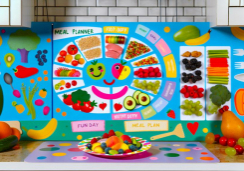Think Carbs Are Essential? Try This Meal Plan
You might believe that carbs are the cornerstone of every diet, but what if you discovered that's not necessarily the case?
As you contemplate tweaking your nutritional habits, consider this meal plan that challenges the conventional wisdom by offering satisfying, carb-conscious alternatives.
It's designed to provide you with a diverse array of foods that are both nourishing and low in carbohydrates, ensuring you don't miss out on essential nutrients.
By giving this plan a chance, you'll not only satisfy your curiosity but may also uncover a new understanding of what your body needs.
Stick around to find out how you can maintain energy levels and feel full, all while redefining your relationship with carbs.
Debunking Carb Myths
Let's shatter the widespread myth that all carbohydrates are your diet's enemy; in truth, they're an essential macronutrient that, when chosen wisely, can be part of a healthy, balanced meal plan.
Complex carbohydrates, like those found in whole grains, are packed with dietary fiber and are digested more slowly than simple sugars, which means they've a lower glycemic index ranking. This slower digestion process prevents large spikes in your blood sugar level, offering a steady stream of energy and supporting sustained fullness.
On the other hand, refined grains and foods with added sugars often carry a high glycemic index ranking, leading to quick rises in blood sugar that can be detrimental in the long run. It's crucial to differentiate between these types of carbs.
While you may have heard that carbs are the enemy, the truth is that natural, fiber-rich, nutrient-dense carbohydrates like fruits, vegetables, and whole grains offer numerous health benefits. So, instead of cutting carbs outright, focus on the quality of the carbs you're eating. Limit added sugars and refined grains, and make complex carbohydrates a staple in your diet for a balanced and nutritious approach to eating.
Low-Carb Meal Basics
Having shattered the myths surrounding carbohydrates, it's essential to explore how a low-carb meal plan fits into a healthy diet and what basics you should know to get started. The key focus of low-carb meal basics is to reduce intake of carbohydrate-containing foods that are high in calories and can lead to weight gain, while still maintaining a balanced diet.
Here are the fundamental components of a low-carb meal plan:
- Complex Carbs: Choose complex carbs like whole grains and legumes, which are digested more slowly, helping you to feel full longer and maintain stable blood sugar levels.
- Fruits and Vegetables: Don't skimp on fruits and vegetables. They're low in calories and packed with nutrients, fiber, and can contribute to heart health.
- Protein: Incorporate a variety of proteins, such as lean meats, fish, and low-fat dairy products to support muscle health and satiety.
- Healthy Fats: Include sources of healthy fats, such as avocados, nuts, and seeds, which are essential for nutrient absorption and can help you feel satisfied.
- Hydration: Stay hydrated with water and other low-calorie beverages to support overall health and aid digestion.
Balancing these elements can help manage your weight and promote overall well-being while reducing your carbohydrate intake.
Planning Your Low-Carb Week
To embark on a low-carb week, start by structuring your meal plan around whole-food-based carbohydrates, ensuring you incorporate a variety of fiber-rich and nutrient-dense options. Pick foods like quinoa, oats, sweet potatoes, lentils, strawberries, and black beans, which aren't only low in carbs but also high in essential nutrients. These choices can help you feel fuller for longer, potentially reducing the risk of heart disease and stroke by supporting balanced blood sugar levels and healthy weight management.
Incorporate whole grains rather than processed foods like white bread, which often have a higher glycemic index ranking and can spike blood sugar levels. By selecting low-carb options with a lower glycemic index, you can better manage your net carb intake, an important factor outlined in the Dietary Guidelines for Americans.
Carefully read the Nutrition Facts label when planning your meals. This helps you avoid hidden sugars and carbs that are commonly found in processed foods. Remember that portion control is key to keeping your blood sugar levels stable throughout the week. By planning your meals thoughtfully and choosing high-fiber, whole-food-based carbs, you'll set yourself up for a successful, health-focused low-carb week.
Delicious Low-Carb Recipes
You'll delight in the variety and flavor of these carefully curated low-carb recipes, from a hearty Chickpea & Quinoa Bowl to a nourishing Quinoa & Chia Oatmeal Mix, each designed to enrich your meal plan without overloading on carbohydrates.
Including whole grains like quinoa ensures you're getting essential B vitamins, while also keeping you satisfied with a lower glycemic index, meaning they're not quickly digested, which is better for your heart.
Here's a list of low-carb staples to mix and match in your meals:
- Sweet Potatoes: A nutrient-dense choice that adds a sweet twist without spiking your blood sugar.
- Lentils and Peas: High in protein and fiber, peas and lentils are versatile and nutritious, making them a great addition to any healthy diet.
- High-Protein Pasta: Swap traditional pasta for a high-protein alternative to keep it low-carb yet satisfying.
- Whole-Grain Bread: Opt for slices that are rich in fiber and full of vitamins and minerals.
- Berries and Low-Fat Dairy: Combine fruits and low-fat dairy for a delicious, balanced snack.
Incorporating these foods into your diet ensures you're not missing out on crucial nutrition. They provide a variety of vitamins and minerals while contributing to a healthy diet.
Enjoy creating meals that are as delicious as they're nutritious!
Managing Cravings and Snacks
Understanding your cravings and learning to manage them is key to maintaining a successful carb-free meal plan. Cravings often stem from triggers like stress or boredom. Instead of reaching for high-carb snacks like white rice or potatoes that can spike your blood sugar, choose options with a low glycemic index.
Healthy eating involves selecting nutritious foods that satisfy without providing empty calories. Opt for snacks that combine protein and healthy fats, such as nuts or Greek yogurt, which can help keep you full and prevent overeating. These snacks are devoid of the simple carbs found in snack foods like chips or cookies.
Remember, though, that while whole grains are often considered part of a balanced diet due to their B vitamins and fiber content, they aren't part of a carb-free meal plan.
Plan and prepare your snacks in advance to combat hunger pangs without derailing your diet. By doing so, you'll ensure that you have access to healthy options when cravings hit. Additionally, practicing mindful eating by recognizing your body's hunger and satiety signals can help you avoid mindless snacking. This way, you'll maintain your healthy eating goals while still enjoying delicious and satisfying snack choices.
Frequently Asked Questions
Are Carbohydrates Essential in Diet?
Carbs aren't strictly essential; your body can use ketones for energy. Keto diet basics show benefits like metabolic flexibility. Yet, carb myths debunked, they can boost athletic performance with proper carb cycling strategies.
What Is a Good Carb Intake During Meal?
Aim for complex carbs with low glycemic index, like fiber-rich plant-based options, and consider carb timing strategies. Carb cycling can adjust intake if you're carb-sensitive, balancing ketogenic alternatives and resistant starches.
What Diet Should Be Carbs?
Your diet should balance carb cycling benefits, fiber intake, and understanding the glycemic index, while considering keto diet risks and carbohydrate density. Don't fall for low carb misconceptions or sugar addiction myths.
What Is the Number 1 Carb to Avoid?
You should avoid added sugars, the top carb culprit. These sugars, found in processed carbs, can increase insulin resistance and have a high glycemic index, lacking nutrients and posing health risks.
Conclusion
You've seen it's possible to thrive on a low-carb diet, debunking the myth that they're indispensable. By focusing on nutrient-rich foods like quinoa, oats, and lentils, you've learned the ropes of low-carb meal planning.
Delicious recipes have added variety to your week, and smart snacking has kept cravings at bay. Stick with it, and you'll likely notice positive changes in your body and energy levels.
Keep exploring and adjusting—your perfect balance is within reach.










